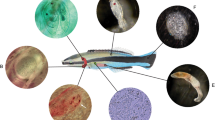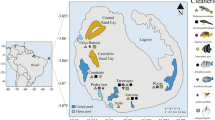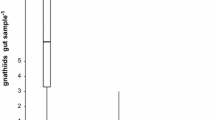Abstract
Apart from cleaner fish, there are many reports on cleaning by shrimps, yet whether shrimps actually ‘clean’, i.e. eat parasites in the wild, has not been demonstrated. For the first time, we show that, conclusively, cleaner shrimp in the wild do clean. We found crustacean ectoparasites from the Family Gnathiidae and the Class Copepoda in the gut contents of wild cleaner shrimp, Urocaridella sp. and Periclimenes holthuisi. In addition, they ate parasitic monogenean flatworms, Benedenia sp., offered to them in the laboratory. Finally, P. holthuisi, significantly reduced monogenean, Benedenia sp., loads by 74.5% on captive surgeonfish Ctenochaetus striatus within 48 h. Such large reductions in parasite loads are likely to benefit individual fish. These results emphasise the need for more information on the ecological role of cleaner shrimp on coral reefs.

Similar content being viewed by others
References
Bshary R (2003) The cleaner wrasse, Labroides dimidiatus, is a key organism for reef fish diversity at Ras Mohammed national Park, Egypt. J Anim Ecol 72:169–176
Bshary R, Grutter AS (2002a) Asymmetric cheating opportunities and partner control in a cleaner fish mutualism. Animal Behav 63:547–555
Bshary R, Grutter AS (2002b) Experimental evidence that partner choice is a driving force in the payoff distribution among cooperators or mutualists: the cleaner fish case. Ecol Lett 5:130–136
Bunkley-Williams L, Williams EH (1998) Ability of pederson cleaner shrimp to remove juveniles of the parasitic cymothoid isopod, Anilocra haemuli, from the host. Crustaceana 71:862–869
Côté I (2001) Evolution and ecology of cleaning symbioses in the sea. Oceanogr Mar Biol Annu Rev 38:311–355
Debelius H (1999) Crustacea guide of the world. Ikan, Frankfurt
Ellis GR (1985) Cleaner shrimp. Freshwater Mar Aquar 8:83–86
Ernst I, Whittington ID (1996) Hatching rhythms in the Capsalid Monogeneans Benedenia lutjani from the skin and B. rohdei from the gills of Lutjanus carponotatus at Heron Island, Queensland, Australia. Int J Parasitol 26:1191–1204
Feder HM (1966) Cleaning symbiosis in the marine environment. In: Henry SM (ed) Symbiosis, vol 1. Academic Press, New York, pp327–380
Gorlick DL, Atkins PD, Losey GS (1987) Effect of cleaning by Labroides dimidiatus (Labridae) on an ectoparasite population infecting Pomacentrus vaiuli (Pomacentridae) at Enewetak Atoll. Copeia 1:41–45
Grutter AS (1994) Spatio-temporal variations of the ectoparasites of seven reef fish species from Lizard Island Heron Island. Mar Ecol Prog Ser 115:21–30
Grutter AS (1995) Comparison of methods for sampling ectoparasites from coral reef fishes. Mar Freshwater Res 46:897–903
Grutter AS (1996) Parasite removal rates by the cleaner wrasse Labroides dimidiatus. Mar Ecol Progress Ser 130:61–70
Grutter AS (1997) Spatio-temporal variation and feeding selectivity in the diet of the cleaner fish Labroides dimidiatus. Copeia 1997:346–355
Grutter AS (1999) Cleaner fish really do clean. Nature 398:672–673
Grutter AS (2002) Cleaning behaviour from the parasite’s perspective. Parasitology Supplement 124:565–581
Grutter AS, Deveney MR, Whittington ID, Lester RJG (2003) The cleaner fish Labroides dimidiatus affects the capsalid monogenean Benedenia lolo on the labrid fish Hemigymnus melapterus. J Fish Biol 61:1098–1108
Nicolette P (1990) Symbiosis: nature in partnership. Blandford, London
Nunes AJP, Goddard S, Gesteira TCV (1996) Feeding activity patters of the Southern brown shrimp Penaeus subtilis under semi-intensive culture in NE Brazil. Aquaculture 144:371–386
Paperna I, Por FD (1977) Preliminary data on the Gnathiidae (Isopoda) of the Northern Red Sea, the Bitter Lakes and the Eastern Mediterranean and the Biology of Gnathia piscivora n. sp. Rapp Comm Int Mer Medit 24(4):195–197
Rhode K (2002) Ecology and biogeography of marine parasites. Advance Mar Biol 43:2–86
Spotte S (1998) “Cleaner” shrimps? Helgolander Meeresuntersuchungen 52:59–64
Tammi J, Lappalainen A, Mannio J, Rask M, Vuorenmaa J (1999) Effects of eutrophication on fish and fisheries in Finnish lakes: a survey based on random sampling. Fish Manage Ecol 6:173–186
Thoney DA, Hargis WJ (1991) Monogenea (Platyhelminthes) as hazards for fish in confinement. Annu Rev Fish Disease 1:133–153
Turnbull T (1981) A study of the symbiotic relationship between the palaemonid shrimp Periclimenes pedersoni Chace (Crustacea, Decapoda, Caridea) and certain species of serranid fishes in the Bahamas. PhD Thesis, New York University
Van Tassell JL, Brito A, Bortone SA (1994) Cleaning behavior among marine fishes and invertebrates in the Canary Islands. Cybium 18(2):117–127
Walls JG (1983) Two colorful cleaner shrimp of the genus Lysmata. Trop Fish Hobbyist 31(11):54–56
Whittington ID (1998) Diversity ‘down under’: monogeneans in the Antipodes (Australia) with a prediction of monogenean biodiversity worldwide. Int J Parasitol 28:1481–1493
Whittington ID, Deveney MR, Wyborn SJ (2001) A revision of Benedenia Diesing, 1858 including a redescription of B. sciaenae (van Beneden, 1856) O dhner, 1905 and recognition of Menziesia Gibson, 1976 (Monogenea: Capsalidae). J Natural Hist 35:663–777
Acknowledgements
We thank R. Jacob, K. Schleit, M. Gauthier, R. Garcia Novoa, C. Jones and H. Parks, for assistance in the field; M. Deveney for comments on monogenean identification, J. Nicholls, A. Rutstein, S. Hazlitt for commenting on the manuscript; P. Sale and two anonymous referees for discussion and comments; the Lizard Island Research Station staff for their help; and Anne Goldizen for discussions on cleaning behaviour. Funding was provided by the University of Queensland, the Australian Museum in the form of a 2002–2004 Lizard Island Doctoral Fellowship (J.H.A.B.), by the Australian Government in the form of an Australian Postgraduate Award (to J.H.A.B.), and by the Australian Research Council (A.S.G.). This is a contribution from the Lizard Island Research Station, a facility of the Australian Museum.
Author information
Authors and Affiliations
Corresponding author
Additional information
Communicated by Ecological Editor P.F. Sale
Rights and permissions
About this article
Cite this article
Becker, J.H., Grutter, A.S. Cleaner shrimp do clean. Coral Reefs 23, 515–520 (2004). https://doi.org/10.1007/s00338-004-0429-3
Received:
Accepted:
Published:
Issue Date:
DOI: https://doi.org/10.1007/s00338-004-0429-3




